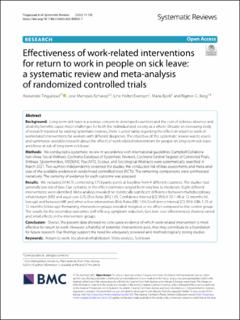| dc.contributor.author | Tingulstad, Alexander | |
| dc.contributor.author | Meneses Echavez, Jose Francisco | |
| dc.contributor.author | Holtet Evensen, Line | |
| dc.contributor.author | Bjerk, Maria | |
| dc.contributor.author | Berg, Rigmor | |
| dc.date.accessioned | 2022-11-10T11:42:25Z | |
| dc.date.available | 2022-11-10T11:42:25Z | |
| dc.date.created | 2022-10-14T12:18:05Z | |
| dc.date.issued | 2022 | |
| dc.identifier.citation | Systematic Reviews. 2022, 11 (1), 1-16. | en_US |
| dc.identifier.issn | 2046-4053 | |
| dc.identifier.uri | https://hdl.handle.net/11250/3031142 | |
| dc.description.abstract | Long-term sick leave is a serious concern in developed countries and the cost of sickness absence and disability benefts cause major challenges for both the individual and society as a whole. Despite an increasing body of research reported by existing systematic reviews, there is uncertainty regarding the efect on return to work of workrelated interventions for workers with diferent diagnoses. The objective of this systematic review was to assess and summarize available research about the efects of work-related interventions for people on long-term sick leave and those at risk of long-term sick leave. Methods: We conducted a systematic review in accordance with international guidelines. Campbell Collabora tion (Area: Social Welfare), Cochrane Database of Systematic Reviews, Cochrane Central Register of Controlled Trials, Embase, Epistemonikos, MEDLINE, PsycINFO, Scopus, and Sociological Abstracts were systematically searched in March 2021. Two authors independently screened the studies. We conducted risk of bias assessments and meta-anal yses of the available evidence in randomized controlled trials (RCTs). The remaining comparisons were synthesized narratively. The certainty of evidence for each outcome was assessed. Results: We included 20 RCTs comprising 5753 participants at baseline from 4 diferent countries. The studies had generally low risk of bias. Our certainty in the efect estimates ranged from very low to moderate. Eight diferent interventions were identifed. Meta-analysis revealed no statistically signifcant diference between multidisciplinary rehabilitation (MR) and usual care (US) (Risk Ratio [RR] 1.01; Confdence Interval [CI] 95% 0.70-1.48 at 12 months fol low-up) and between MR and other active intervention (Risk Ratio [RR] 1.04; Confdence Interval [CI] 95% 0.86-1.25 at 12 months follow-up). Remaining intervention groups revealed marginal, or no efect compared to the control group. The results for the secondary outcomes (self-efcacy, symptom reduction, function, cost-efectiveness) showed varied and small efects in the intervention groups. Conclusion: Overall, the present data showed no conclusive evidence of which work-related intervention is most efective for return to work. However, a handful of potential interventions exist, that may contribute to a foundation for future research. Our fndings support the need for adequately powered and methodologically strong studies. | en_US |
| dc.language.iso | eng | en_US |
| dc.publisher | BMC | en_US |
| dc.rights | Navngivelse 4.0 Internasjonal | * |
| dc.rights.uri | http://creativecommons.org/licenses/by/4.0/deed.no | * |
| dc.subject | Vocational rehabilitation | en_US |
| dc.subject | Return to work | en_US |
| dc.subject | Sick leave | en_US |
| dc.title | Effectiveness of work-related interventions for return to work in people on sick leave: A systematic review and meta-analysis of randomized controlled trials | en_US |
| dc.type | Peer reviewed | en_US |
| dc.type | Journal article | en_US |
| dc.description.version | publishedVersion | en_US |
| cristin.ispublished | true | |
| cristin.fulltext | original | |
| cristin.qualitycode | 1 | |
| dc.identifier.doi | 10.1186/s13643-022-02055-7 | |
| dc.identifier.cristin | 2061467 | |
| dc.source.journal | Systematic Reviews | en_US |
| dc.source.volume | 11 | en_US |
| dc.source.issue | 1 | en_US |
| dc.source.pagenumber | 1-16 | en_US |

